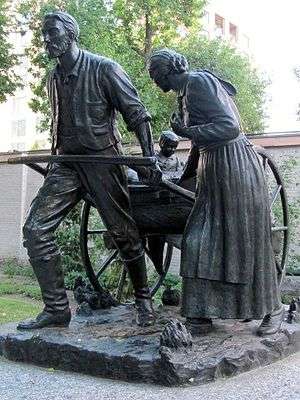John Rowe Moyle
John Rowe Moyle (22 February 1808, Wendron, Cornwall, England – 15 January 1889, Alpine, Utah Territory)[1][2] was a Mormon pioneer and a settler of Alpine, Utah. He was a master stonemason for the Salt Lake Temple, and was the carver of the inscription "Holiness to the Lord" on the temple's east side.[3][4]

Biography
Moyle was born in Cornwall, England, to James and Elizabeth Rowe Moyle.[1][2][5][6] In his youth he worked in the tin mines of Cornwall, and later became a stonemason, learning the trade from his father.[1][7] He and his family converted to The Church of Jesus Christ of Latter-day Saints (LDS Church) in 1851. Moyle travelled to Utah Territory with the first handcart company in 1856, settling in Alpine two years later.[1][7]
Both a farmer and a stonemason, Moyle traveled to Salt Lake City frequently to serve on the temple construction.[4] Moyle installed the Temple's circular staircase and carved the inscription "Holiness to the Lord" on the east side of the Temple.[1][4] In 1863, Moyle built a chapel in Alpine. He also built an Indian fort to protect his family during the invasion of Salt Lake City by federal troops.[8]
Moyle suffered a compound fracture of the leg when he was kicked by a cow, necessitating the leg's amputation by his family and friends. Moyle subsequently carved a wooden leg for himself and learned how to use it. After the accident, he would again walk to Salt Lake City and work on the temple.[1][3][4]
Moyle was married to Phillippa Beer, who was born in Devonshire, England,[1][9] and (polygamously) to Mary Ann Williams.[1][4] Moyle's son, James Moyle, became foreman of the builders and stone-cutters on the Temple Block in 1875 and general superintendent of the temple in 1886.[10] Moyle was the grandfather of James Henry Moyle, a prominent Utah politician, and the great-grandfather of Henry D. Moyle, an apostle of the LDS Church.[7][11]
Legacy
Torleif S. Knaphus used Moyle's likeness (along with several others) as the inspiration for the father's face on the Handcart Pioneer Monument on Temple Square.[12] Moyle is the subject of the 2008 short film Only a Stonecutter, directed by T. C. Christensen and starring Bruce Newbold.[13][14]
References
- Moyle, Richard W. (1998). "John Rowe Moyle". In Youngberg, Florence C (ed.). Conquerors of the West: Stalwart Mormon Pioneers. III. Compiled by National Society of the Sons of Utah Pioneers (Salt Lake City, Utah). Agreka Books. pp. 1733–1735. ISBN 1-888106-31-X. LCCN 98-72414.
- Lee Drew (20 February 2004). "John Rowe Moyle". Find a Grave. Retrieved 5 January 2013.
- Uchtdorf, Dieter F. (November 2008), "Lift Where You Stand", Ensign, LDS Church
- Lindquist, Rusty (5 October 2008). "Holiness to the Lord, the story of John Rowe Moyle". Mormon Conversations. Retrieved 3 January 2013.
- "John Rowe Moyle". Ancestry.com. 2013. Retrieved 6 January 2013.
- Some sources give the name of John Rowe Moyle's father as Stephen. See:
Hinckley, Gordon B. (1951). James Henry Moyle, the story of a distinguished American and an honored churchman. Based in part on the research and manuscript writings of John Henry Evans. Deseret Book Company. p. 11. OCLC 13963049.;
Daughters of Utah Pioneers (1952). Treasures of Pioneer History. 6. Compiled by Kate B. Carter. Daughters of Utah Pioneers. p. 233. - Poll, Richard D. (1999). Larson, Stan (ed.). Working the Divine Miracle: The Life of Apostle Henry D. Moyle. Salt Lake City: Signature Books. pp. 1–4. ISBN 1-56085-129-5.
- Todd, Arthur Cecil (1968). The Cornish miner in America: the contribution to the mining history of the United States by immigrant Cornish miners—the men called Cousin Jacks. Western lands and waters. 6. Barton. p. 239.
- Lee Drew (20 February 2004). "Phillippa Beer Moyle". Find a Grave. Retrieved 3 January 2013.
- Whitney, Orson F. (1904). History of Utah: Comprising Preliminary Chapters on the Previous History of Her Founders Accounts of Early Spanish and American Explorations in the Rocky Mountain Region, the Advent of the Mormon Pioneers, the Establishment and Dissolution of the Provisional Government of the State of Deseret, and the Subsequent Creation and Development of the Territory. 4. Salt Lake City, Utah: George Q. Cannon and Sons. pp. 457–458. OCLC 4995807.
- Uchtdorf erroneously refers to Henry D. Moyle as John Rowe Moyle's "grandson".
- Lloyd, R. Scott (7 February 2009), "Sculpture bound for Norway", Church News,
... [G]randfather used a number of models for his work, but for the father in the handcart sculpture, he used, among others, the likeness of John Rowe Moyle, a handcart pioneer and a stonecutter who worked on the Salt Lake Temple.
- Only a Stonecutter on IMDb
- Decker, Jonathan (2013). 250 Great Movies for Latter-day Families. Springville, Utah: CFI. p. 162. ISBN 978-1-4621-1218-0. LCCN 2013021995.